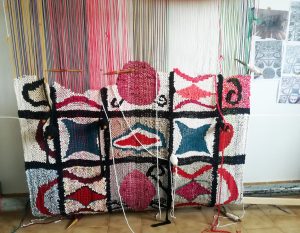Teresa Lanceta
b. 1951, Barcelona, Spain; lives in Mutxmel, Spain
CONTRIBUTION
Teresa Lanceta/Pedro G. Romero
Gallinero (Chicken Coop), 2019
Live broadcast of tapestry (wool, cotton, acrylic, linen, rags, seeds, 6.5 × 1.65 m) installed in the henhouse of Langegården farm, Bergen; texts
The Romans gave us the legal system, but whenever a decree was passed in the Senate, a roost of prophetic chickens would have their say on the fate of this or that law. This relationship with magic mediated by chickens has often been parodied. In Rómulo Magno, Friedrich Dürrenmatt tells of the Empire crumbling while the emperor amuses himself with his chickens. The anecdote is based on Honorius, the emperor who thought only of the safety of one of his chickens (whose name was Rome) when he was told of the sacking of the city of Rome by Alaric the Goth. In City of God, Saint Augustine uses this episode of madness as an example of the decline of paganism. When English painter John William Waterhouse depicted the scene, he placed the emperor’s chicken coop on an anachronistic Persian rug. And this is precisely the point of departure for the collaboration between Pedro G. Romero and Teresa Lanceta, an artist who has been weaving rugs for many years. The two had met and laughed about Martin Kippenberger’s Chicken Disco (1953–97). Now they have spent months researching the perception of chickens, the way they understand space and time, in order to weave a rug that will hold them. Derrida called for what he termed the ‘animot’ to combine the cultural knowledge of animals with that which is zoologically inherent in them: being, indifferent to culture. This dual purpose led them to start a conversation about the ‘chicken thieves’, as Roma are still referred to in many parts of Europe. And they are still talking.
Teresa Lanceta and Pedro G. Romero had lived in the same city and even in the same building without meeting; they were not aware of each other. A few years ago Romero confessed to Lanceta his longstanding admiration of her early textile works, particularly those she had made in Barcelona, Granada, Madrid and Seville, when she had shared part of her life and living spaces with Roma people. They have continued to work together in various ways, here and there, on exhibitions and texts, and they are even putting together a story that began telling itself and has brought them here.
RELATED PLATFORMS

